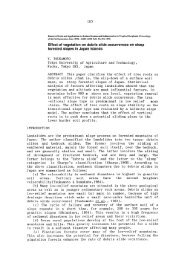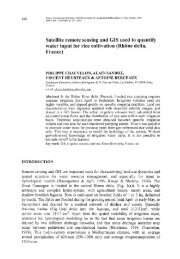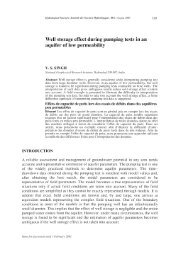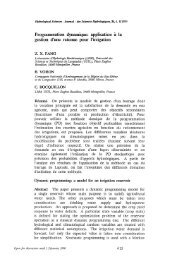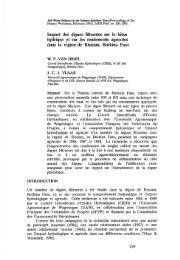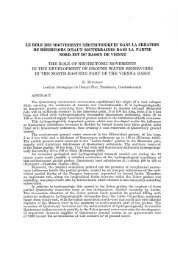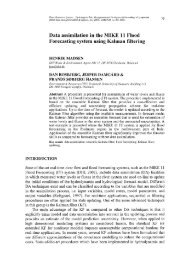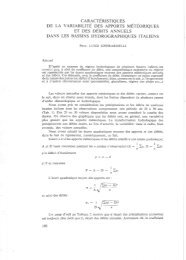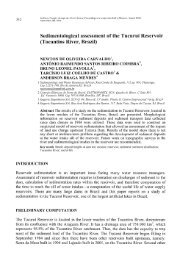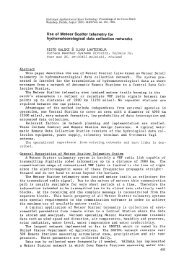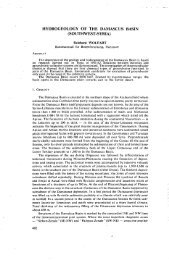Impact of chemical grout injection on urban groundwater - IAHS
Impact of chemical grout injection on urban groundwater - IAHS
Impact of chemical grout injection on urban groundwater - IAHS
You also want an ePaper? Increase the reach of your titles
YUMPU automatically turns print PDFs into web optimized ePapers that Google loves.
INTRODUCTION<br />
<str<strong>on</strong>g>Impact</str<strong>on</strong>g>s <str<strong>on</strong>g>of</str<strong>on</strong>g> Urban Growth <strong>on</strong> Surface Water and Groundwater Quality (Proceedings <str<strong>on</strong>g>of</str<strong>on</strong>g> IUGG 99<br />
Symposium HS5, Birmingham, July 1999). <strong>IAHS</strong> Publ. no. 259, 1999.<br />
<str<strong>on</strong>g>Impact</str<strong>on</strong>g> <str<strong>on</strong>g>of</str<strong>on</strong>g> <str<strong>on</strong>g>chemical</str<strong>on</strong>g> <str<strong>on</strong>g>grout</str<strong>on</strong>g> <str<strong>on</strong>g>injecti<strong>on</strong></str<strong>on</strong>g> <strong>on</strong> <strong>urban</strong><br />
<strong>groundwater</strong><br />
MATTHIAS EISWIRTH, RENKE OHLENBUSCH &<br />
KLAUS SCHNELL<br />
Department <str<strong>on</strong>g>of</str<strong>on</strong>g> Applied Geology, University <str<strong>on</strong>g>of</str<strong>on</strong>g> Karlsruhe, Kaiserstr. 12, D-76128 Karlsruhe,<br />
Germany<br />
e-mail: matmias.eiswirth@bio-geo.uni-karlsruhe.de<br />
Abstract. In many <strong>urban</strong> areas, <str<strong>on</strong>g>grout</str<strong>on</strong>g> <str<strong>on</strong>g>injecti<strong>on</strong></str<strong>on</strong>g>s have been used to seal porous<br />
soil within the last decades. Silica hydrogels have been particularly applied in<br />
foundati<strong>on</strong> engineering practice due to their wide applicability and ec<strong>on</strong>omic<br />
advantages. For example in the City <str<strong>on</strong>g>of</str<strong>on</strong>g> Berlin between 1990 and 1995 about<br />
100 000 m 3<br />
<str<strong>on</strong>g>of</str<strong>on</strong>g> silicate gels were injected into porous aquifers. Therefore the<br />
envir<strong>on</strong>mental authority <str<strong>on</strong>g>of</str<strong>on</strong>g> Berlin insisted <strong>on</strong> detailed investigati<strong>on</strong>s <str<strong>on</strong>g>of</str<strong>on</strong>g><br />
potential <strong>groundwater</strong> c<strong>on</strong>taminati<strong>on</strong> risks. This paper presents the results <str<strong>on</strong>g>of</str<strong>on</strong>g><br />
detailed investigati<strong>on</strong>s <strong>on</strong> an excavati<strong>on</strong> site over a period <str<strong>on</strong>g>of</str<strong>on</strong>g> two years. Two<br />
main topics are the use <str<strong>on</strong>g>of</str<strong>on</strong>g> artificial and natural tracers as well as transport<br />
modelling to quantify potential changes in <strong>groundwater</strong> chemistry and to predict<br />
both l<strong>on</strong>gevity and toxicity <str<strong>on</strong>g>of</str<strong>on</strong>g> silica <str<strong>on</strong>g>grout</str<strong>on</strong>g>s.<br />
C<strong>on</strong>structi<strong>on</strong> <str<strong>on</strong>g>of</str<strong>on</strong>g> horiz<strong>on</strong>tal <str<strong>on</strong>g>grout</str<strong>on</strong>g>ed diaphragms, which are c<strong>on</strong>nected to impermeable<br />
vertical cut-<str<strong>on</strong>g>of</str<strong>on</strong>g>fs, are required when excavati<strong>on</strong>s extend below the water table and<br />
<strong>groundwater</strong> lowering techniques cannot be used (Tausch, 1985; N<strong>on</strong>veiller, 1989).<br />
Such diaphragms are usually 1-2 m in thickness. Because <str<strong>on</strong>g>of</str<strong>on</strong>g> the uplift pressure, they<br />
must be c<strong>on</strong>structed at a level significantly below the proposed base <str<strong>on</strong>g>of</str<strong>on</strong>g> the excavati<strong>on</strong><br />
in order to prevent blow-out into the excavati<strong>on</strong> (Bell, 1993). The design <str<strong>on</strong>g>of</str<strong>on</strong>g> a<br />
successful <str<strong>on</strong>g>grout</str<strong>on</strong>g>ing programme requires the selecti<strong>on</strong> <str<strong>on</strong>g>of</str<strong>on</strong>g> a suitable <str<strong>on</strong>g>grout</str<strong>on</strong>g> material and<br />
the correct drilling equipment, procedures and <str<strong>on</strong>g>grout</str<strong>on</strong>g>-hole pattern (Karol, 1990). The<br />
most widely used <str<strong>on</strong>g>chemical</str<strong>on</strong>g> <str<strong>on</strong>g>grout</str<strong>on</strong>g>s are silicate <str<strong>on</strong>g>grout</str<strong>on</strong>g>s especially in medium and coarse<br />
sands. These <str<strong>on</strong>g>chemical</str<strong>on</strong>g> <str<strong>on</strong>g>grout</str<strong>on</strong>g>s are true soluti<strong>on</strong>s (Newt<strong>on</strong>ian fluids) which c<strong>on</strong>tain no<br />
suspended solid particles and lack shear strength (Greenwood & Thoms<strong>on</strong>, 1984;<br />
Littlejohn, 1985).<br />
Silicate-aluminate <str<strong>on</strong>g>grout</str<strong>on</strong>g>s are dilute soluti<strong>on</strong>s <str<strong>on</strong>g>of</str<strong>on</strong>g> sodium aluminate (hardener) and<br />
sodium silicate, which are able to penetrate fine sands and sandy silts due to their low<br />
viscosity. On ageing the gel shrinks, becomes opalescent and cracks.<br />
The comm<strong>on</strong>ly applied silica gel has a silica/soda ratio <str<strong>on</strong>g>of</str<strong>on</strong>g> 3.3 by weight. With the<br />
ratio <str<strong>on</strong>g>of</str<strong>on</strong>g> 2 vol. % sodium aluminate (Na20m-Al203T8.9 H2O), 18 vol. % filtered silica<br />
-<br />
gel (Na20-(Si02) n 27.6-H20) and 80 vol. % water the following <str<strong>on</strong>g>chemical</str<strong>on</strong>g> reacti<strong>on</strong><br />
occurs (Eiswirth et al., 1997):<br />
Na 20-(Si0 2)3.3 + 0.16 (Na 20)i.72-Al 203 + 1.11 (H 20)<br />
-> 0.04 Na 8(A10 2)8(Si0 2)82.5 + 2.23 Na +<br />
OH" (1)<br />
187
188 Matthias Eiswirth et al.<br />
Equati<strong>on</strong> (1) indicates that each mol applied silica gel produces 0.04 mol hydrogel<br />
mixture with albitic mineral compositi<strong>on</strong> and 2.23 mol caustic soda soluti<strong>on</strong>. As a<br />
result the pH value as well as the c<strong>on</strong>tents <str<strong>on</strong>g>of</str<strong>on</strong>g> sodium, silicate, aluminium and organic<br />
compounds are increasingly significant in the drainage water and temporarily in the<br />
adjacent <strong>groundwater</strong>. All <str<strong>on</strong>g>chemical</str<strong>on</strong>g> <str<strong>on</strong>g>grout</str<strong>on</strong>g>s are hydrogels and as such, may redissolve<br />
<strong>on</strong> prol<strong>on</strong>ged c<strong>on</strong>tact with <strong>groundwater</strong>. The process <str<strong>on</strong>g>of</str<strong>on</strong>g> dissoluti<strong>on</strong> governs the<br />
permanence <str<strong>on</strong>g>of</str<strong>on</strong>g> the <str<strong>on</strong>g>grout</str<strong>on</strong>g> and <str<strong>on</strong>g>grout</str<strong>on</strong>g> treatment as well as the l<strong>on</strong>g term toxicity, if any,<br />
associated with such treatment.<br />
CASE STUDY IN THE CITY OF BERLIN<br />
In the City <str<strong>on</strong>g>of</str<strong>on</strong>g> Berlin about 100 000 m 3<br />
<str<strong>on</strong>g>of</str<strong>on</strong>g> silicate gels were injected into porous<br />
aquifers between 1990 and 1995, because <strong>groundwater</strong> lowering by dewatering<br />
techniques cannot be used for large excavati<strong>on</strong>s due to envir<strong>on</strong>mental hazards. The<br />
envir<strong>on</strong>mental authority <str<strong>on</strong>g>of</str<strong>on</strong>g> Berlin (SenSUT) therefore insisted in 1995 <strong>on</strong> detailed investigati<strong>on</strong>s<br />
<str<strong>on</strong>g>of</str<strong>on</strong>g> potential <strong>groundwater</strong> c<strong>on</strong>taminati<strong>on</strong> risks due to silica <str<strong>on</strong>g>grout</str<strong>on</strong>g> <str<strong>on</strong>g>injecti<strong>on</strong></str<strong>on</strong>g>s.<br />
In February 1996 the Department <str<strong>on</strong>g>of</str<strong>on</strong>g> Applied Geology, University <str<strong>on</strong>g>of</str<strong>on</strong>g> Karlsruhe<br />
selected a test excavati<strong>on</strong> in Berlin in order to carry out detailed field investigati<strong>on</strong>s<br />
(Fig. 1).<br />
Geology and hydrogeology <str<strong>on</strong>g>of</str<strong>on</strong>g> the excavati<strong>on</strong> site<br />
The selected excavati<strong>on</strong> site, Ringcenter II, is situated in the southern part <str<strong>on</strong>g>of</str<strong>on</strong>g> the<br />
Bamim upland area located at the boundary <str<strong>on</strong>g>of</str<strong>on</strong>g> the Warsaw-Berlin stream channel<br />
(Fig. 1). At this locati<strong>on</strong> glacial sands with a thickness <str<strong>on</strong>g>of</str<strong>on</strong>g> around 2 m are underlain by<br />
till with a maximum thickness <str<strong>on</strong>g>of</str<strong>on</strong>g> 12 m tlunning-out to the stream channel boundary in<br />
the south. The till layer is underlain in places by a silt. The main aquifer below c<strong>on</strong>sists<br />
<str<strong>on</strong>g>of</str<strong>on</strong>g> medium to coarse grained glacial sands.<br />
The main aquifer is located in the lower glacial sands and is bounded above by the<br />
silt and/or till at nearly 22 m above mean sea level (m a.m.s.l.), and below by Miocene<br />
brown-coal clay at about 90 m below sea level. The aquifer is c<strong>on</strong>fined with an estimated<br />
average thickness <str<strong>on</strong>g>of</str<strong>on</strong>g> around 110 m. Pumping tests, tracer tests and grain size<br />
analyses enabled the estimati<strong>on</strong> <str<strong>on</strong>g>of</str<strong>on</strong>g> the following hydrogeological parameters:<br />
hydraulic c<strong>on</strong>ductivity (K) = 4.5>
<str<strong>on</strong>g>Impact</str<strong>on</strong>g> <str<strong>on</strong>g>of</str<strong>on</strong>g> <str<strong>on</strong>g>chemical</str<strong>on</strong>g> <str<strong>on</strong>g>grout</str<strong>on</strong>g> <str<strong>on</strong>g>injecti<strong>on</strong></str<strong>on</strong>g> <strong>on</strong> <strong>urban</strong> <strong>groundwater</strong> 189<br />
Fig. 1 Maps <str<strong>on</strong>g>of</str<strong>on</strong>g> the excavati<strong>on</strong> Ringcenter II in Berlin, Germany and <str<strong>on</strong>g>of</str<strong>on</strong>g> the four main<br />
c<strong>on</strong>structi<strong>on</strong> sites <str<strong>on</strong>g>of</str<strong>on</strong>g> the excavati<strong>on</strong> with the positi<strong>on</strong> <str<strong>on</strong>g>of</str<strong>on</strong>g> the <strong>groundwater</strong> observati<strong>on</strong><br />
wells (bgm = base <str<strong>on</strong>g>grout</str<strong>on</strong>g> membrane).<br />
The hydro<str<strong>on</strong>g>chemical</str<strong>on</strong>g> analysis <str<strong>on</strong>g>of</str<strong>on</strong>g> the <strong>groundwater</strong> has identified water <str<strong>on</strong>g>of</str<strong>on</strong>g><br />
hydrocarb<strong>on</strong>, alkaline origin with a slight corrosive character. The parameters <str<strong>on</strong>g>of</str<strong>on</strong>g> pHvalue,<br />
specific electrical c<strong>on</strong>ductivity (SEC), and <str<strong>on</strong>g>chemical</str<strong>on</strong>g> i<strong>on</strong> compositi<strong>on</strong> show<br />
values below the <strong>groundwater</strong> protecti<strong>on</strong> list <str<strong>on</strong>g>of</str<strong>on</strong>g> the City <str<strong>on</strong>g>of</str<strong>on</strong>g> Berlin.<br />
SITE INVESTIGATIONS<br />
In 1995 the Department <str<strong>on</strong>g>of</str<strong>on</strong>g> Applied Geology, University <str<strong>on</strong>g>of</str<strong>on</strong>g> Karlsruhe, started with detailed<br />
field investigati<strong>on</strong>s <strong>on</strong> a selected excavati<strong>on</strong> in Berlin. Besides geological and<br />
hydrogeological studies, extensive <str<strong>on</strong>g>chemical</str<strong>on</strong>g> analyses have been carried out every week<br />
within 15 <strong>groundwater</strong> observati<strong>on</strong> wells surrounding the excavati<strong>on</strong>. The results <str<strong>on</strong>g>of</str<strong>on</strong>g><br />
laboratory column and batch tests, together with the <strong>groundwater</strong> analyses after<br />
<str<strong>on</strong>g>grout</str<strong>on</strong>g>ing, enabled the selecti<strong>on</strong> <str<strong>on</strong>g>of</str<strong>on</strong>g> <strong>groundwater</strong> parameters as natural tracers. In comparis<strong>on</strong><br />
to the transport behaviour <str<strong>on</strong>g>of</str<strong>on</strong>g> the natural tracers Na +<br />
, Al 3+<br />
and S1O2, the<br />
artificial tracers uranine, pyranine and sulphorhodamine were injected during different<br />
tracing experiments. The results lead to an estimati<strong>on</strong> <str<strong>on</strong>g>of</str<strong>on</strong>g> the transport velocity va <str<strong>on</strong>g>of</str<strong>on</strong>g><br />
about 0.30 m day" 1<br />
under natural flow c<strong>on</strong>diti<strong>on</strong>s with a hydraulic gradient I = 0.002<br />
(Eiswirth et al., 1997). These results verified the data yielded from grain size analysis,<br />
pumping tests and numerical modelling.<br />
Hydrochemistry <str<strong>on</strong>g>of</str<strong>on</strong>g> drainage water and <strong>groundwater</strong><br />
In order to estimate the influence <str<strong>on</strong>g>of</str<strong>on</strong>g> silica <str<strong>on</strong>g>grout</str<strong>on</strong>g>s <strong>on</strong> the adjacent <strong>groundwater</strong>, hydro<str<strong>on</strong>g>chemical</str<strong>on</strong>g><br />
analyses <str<strong>on</strong>g>of</str<strong>on</strong>g> 28 <strong>groundwater</strong> observati<strong>on</strong> wells, in additi<strong>on</strong> to drainage water,<br />
have been carried out frequently (Fig. 1).
190 Matthias Eiswirth et al.<br />
Drainage water The analysis <str<strong>on</strong>g>of</str<strong>on</strong>g> drainage water carried out during the dewatering<br />
period showed sodium, aluminium and silica as the <str<strong>on</strong>g>chemical</str<strong>on</strong>g> parameters significantly<br />
increasing in <strong>groundwater</strong> that c<strong>on</strong>tacted silica gel. Therefore these parameters can be<br />
used as natural tracers to estimate <strong>groundwater</strong> c<strong>on</strong>taminati<strong>on</strong> by silica <str<strong>on</strong>g>grout</str<strong>on</strong>g>s.Bey<strong>on</strong>d<br />
this, equati<strong>on</strong> 1 indicates the formati<strong>on</strong> <str<strong>on</strong>g>of</str<strong>on</strong>g> caustic soda soluti<strong>on</strong> which causes a distinct<br />
increase in the pH-value. As a result, humic substances are leaching out <str<strong>on</strong>g>of</str<strong>on</strong>g> the organic<br />
comp<strong>on</strong>ents <str<strong>on</strong>g>of</str<strong>on</strong>g> the sediment and this is expressed by the significant increase in the<br />
DOC and SEC (Fig. 2).<br />
Groundwater In c<strong>on</strong>trast to drainage water, the <strong>groundwater</strong> showed no<br />
significant hydro<str<strong>on</strong>g>chemical</str<strong>on</strong>g> variati<strong>on</strong>s caused by the <str<strong>on</strong>g>grout</str<strong>on</strong>g>ing. For example, the<br />
<strong>groundwater</strong> observati<strong>on</strong> well B 17, at a distance <str<strong>on</strong>g>of</str<strong>on</strong>g> about 12.5 m downstream <str<strong>on</strong>g>of</str<strong>on</strong>g> the<br />
excavati<strong>on</strong>, indicated no significant changes in water chemistry. All the hydro<str<strong>on</strong>g>chemical</str<strong>on</strong>g><br />
variati<strong>on</strong>s in the <strong>groundwater</strong> observati<strong>on</strong> well B 17 shown in Fig. 3 are unrelated to<br />
the silica gel <str<strong>on</strong>g>grout</str<strong>on</strong>g>ing and are in fact <str<strong>on</strong>g>of</str<strong>on</strong>g> entirely natural origin.<br />
The hydro<str<strong>on</strong>g>chemical</str<strong>on</strong>g> data for all other observati<strong>on</strong> wells underline these results.<br />
Additi<strong>on</strong>ally it should be remembered that more than two years had passed since the<br />
<str<strong>on</strong>g>grout</str<strong>on</strong>g>ing period started. Therefore it must be menti<strong>on</strong>ed that there is a str<strong>on</strong>g hint that<br />
the influence <str<strong>on</strong>g>of</str<strong>on</strong>g> silica <str<strong>on</strong>g>grout</str<strong>on</strong>g>ing <strong>on</strong> <strong>groundwater</strong> is reduced to a z<strong>on</strong>e <str<strong>on</strong>g>of</str<strong>on</strong>g> <strong>on</strong>ly a very few<br />
metres downstream <str<strong>on</strong>g>of</str<strong>on</strong>g> the silica <str<strong>on</strong>g>grout</str<strong>on</strong>g> diaphragm. This distance varies depending <strong>on</strong><br />
the aquifer type.<br />
Hydro<str<strong>on</strong>g>chemical</str<strong>on</strong>g> modelling and mass balance<br />
For the <str<strong>on</strong>g>injecti<strong>on</strong></str<strong>on</strong>g> <str<strong>on</strong>g>of</str<strong>on</strong>g> the silica <str<strong>on</strong>g>grout</str<strong>on</strong>g> diaphragm at excavati<strong>on</strong> Ringcenter II, the<br />
following materials were used: 112.2 t<strong>on</strong>s Solidur 274 S (sleeve <str<strong>on</strong>g>grout</str<strong>on</strong>g>), 1056.51 t<strong>on</strong>s<br />
filtered silica gel, 108.96 t<strong>on</strong>s 200 SB (sodium aluminate) and 3621.8 m 3<br />
water<br />
(Table 1).
<str<strong>on</strong>g>Impact</str<strong>on</strong>g> <str<strong>on</strong>g>of</str<strong>on</strong>g> <str<strong>on</strong>g>chemical</str<strong>on</strong>g> <str<strong>on</strong>g>grout</str<strong>on</strong>g> <str<strong>on</strong>g>injecti<strong>on</strong></str<strong>on</strong>g> <strong>on</strong> <strong>urban</strong> <strong>groundwater</strong> 191<br />
Date<br />
Fig. 3 Variati<strong>on</strong> <str<strong>on</strong>g>of</str<strong>on</strong>g> aluminium, silica, sodium and DOC <str<strong>on</strong>g>of</str<strong>on</strong>g> <strong>groundwater</strong> observati<strong>on</strong><br />
wellB 17.<br />
Table 1 Silica gel <str<strong>on</strong>g>grout</str<strong>on</strong>g>ing data <str<strong>on</strong>g>of</str<strong>on</strong>g> excavati<strong>on</strong> Ringcenter II.<br />
C<strong>on</strong>structi<strong>on</strong> sites Injecti<strong>on</strong> period Injecti<strong>on</strong> points Injected <str<strong>on</strong>g>grout</str<strong>on</strong>g> mass (W)<br />
Site I 5-18 June 1996 459 278.93<br />
Site II 1-29 July 1996 1480 1151.64<br />
Site III 12 June-10 July 1996 1763 1406.06<br />
Site IV 11 July-7 August 1996 1422 1131.26<br />
Total 5 June-7 August 1996 5124 3967.89<br />
The calculati<strong>on</strong>s in Table 2 shows exemplarily the sodium compounds theoretically<br />
washed out <str<strong>on</strong>g>of</str<strong>on</strong>g> the diaphragm and pumped to the surface with the drainage water up to<br />
October 1996. Until October 1996, the sodium output with the drainage water is <strong>on</strong>ly<br />
about 7% <str<strong>on</strong>g>of</str<strong>on</strong>g> the input mass <str<strong>on</strong>g>of</str<strong>on</strong>g> the silicate <str<strong>on</strong>g>grout</str<strong>on</strong>g>s (Table 2).<br />
Using equati<strong>on</strong> (1), the injected 1056.51 t<strong>on</strong>s <str<strong>on</strong>g>of</str<strong>on</strong>g> silica gel (= 1.396xl0 6<br />
mol) produces<br />
a theoretical maximum <str<strong>on</strong>g>of</str<strong>on</strong>g> 3.113x10 6<br />
mol NaOH equivalent to a theoretically<br />
leachable sodium mass <str<strong>on</strong>g>of</str<strong>on</strong>g> 71.6 t<strong>on</strong>s. Hydro<str<strong>on</strong>g>chemical</str<strong>on</strong>g> analysis <str<strong>on</strong>g>of</str<strong>on</strong>g> the injected silica<br />
Table 2 Sodium c<strong>on</strong>centrati<strong>on</strong>s in drainage water and output mass calculati<strong>on</strong>.<br />
Start<br />
24 June<br />
1996<br />
Drainage<br />
water<br />
output<br />
(V)<br />
Interval<br />
(day)<br />
Output<br />
during<br />
interval<br />
(m 3<br />
)<br />
Mean<br />
rate <str<strong>on</strong>g>of</str<strong>on</strong>g><br />
prodn.<br />
(m 3<br />
day 1<br />
)<br />
Sodium<br />
c<strong>on</strong>e.<br />
(gm- 3<br />
)<br />
Sodium<br />
backgrou<br />
nd<br />
(gm" 3<br />
)<br />
Sodium<br />
output<br />
(gross)<br />
(g)<br />
Sodium<br />
background<br />
(g)<br />
Sodium<br />
output (net)<br />
(g)<br />
25 June 10 1 10 10.00 54 40 13 500 10 000 3500<br />
17 July 260 22 250 11.36 420 40 705 200 162 400 1 542 800<br />
5 August 4320 19 4060 213.68 120 40 187 200 62 400 124 800<br />
14 August 5880 9 1560 173.33 180 40 708 000 824 000 2 884 000<br />
10 October 26480 57 20 600 361.40 100 40 267 000 106 800 160 200<br />
23 October 29150 13 2670 205.38<br />
Sum 121 5 880 900 1 165 600 4 715 300<br />
Chemical analysis (Sodium c<strong>on</strong>tent = 2 vol. %)<br />
Reacti<strong>on</strong> equati<strong>on</strong> (with 1056 to silica gel)<br />
Input<br />
(g)<br />
8.51E407<br />
7.26E+07<br />
Output<br />
(%)<br />
5.54<br />
6.50
192 Matthias Eiswirth et al<br />
<str<strong>on</strong>g>grout</str<strong>on</strong>g>s (sodium aluminate + silica gel + water) yielded a sodium c<strong>on</strong>centrati<strong>on</strong> <str<strong>on</strong>g>of</str<strong>on</strong>g> 2 vol.<br />
%. With the total gel <str<strong>on</strong>g>injecti<strong>on</strong></str<strong>on</strong>g> mass <str<strong>on</strong>g>of</str<strong>on</strong>g> 4338.3 t<strong>on</strong>s, a total <str<strong>on</strong>g>of</str<strong>on</strong>g> 86.77 t<strong>on</strong>s sodium is put<br />
into the ground with the gel. This means at least 15.17 t<strong>on</strong>s <str<strong>on</strong>g>of</str<strong>on</strong>g> sodium (= 17.5%) must<br />
be fixed within the gel diaphragm and is not leachable to <strong>groundwater</strong>.<br />
In order to investigate the reacti<strong>on</strong>s and reacti<strong>on</strong> products within the silica gel soluti<strong>on</strong><br />
and the adjacent <strong>groundwater</strong>, geo<str<strong>on</strong>g>chemical</str<strong>on</strong>g> calculati<strong>on</strong>s with PHREEQE (Apello &<br />
Postma, 1994) have been carried out. Using the <str<strong>on</strong>g>chemical</str<strong>on</strong>g> analysis <str<strong>on</strong>g>of</str<strong>on</strong>g> the silica gel soluti<strong>on</strong><br />
applied at excavati<strong>on</strong> Ringcenter U, the theoretical gel soluti<strong>on</strong> compositi<strong>on</strong> was<br />
calculated. As shown by Eiswirth et al. (1997) for the silica gel soluti<strong>on</strong> applied at Ringcenter<br />
II, mainly feldspars and voids have been be produced and precipitated.<br />
Bey<strong>on</strong>d the above menti<strong>on</strong>ed calculati<strong>on</strong>, the mixing model <str<strong>on</strong>g>of</str<strong>on</strong>g> PHREEQE has<br />
been applied to model the mixing/titrati<strong>on</strong> <str<strong>on</strong>g>of</str<strong>on</strong>g> the silica gel soluti<strong>on</strong> with the<br />
<strong>groundwater</strong>. The results yielded, for nearly every mixing ratio, variable species distributi<strong>on</strong>s<br />
(Eiswirth et al, 1997). For example Na-species (Na +<br />
77%, NaHC03 22%), Alspecies<br />
(AlOFLf 97%) and Si-species (HiSiC^ 99%) have been mainly produced with<br />
the aluminium compounds occurring to 97% as aluminate which is regarded as<br />
immobile. Nevertheless, NaHCCh is formed and less than 77% <str<strong>on</strong>g>of</str<strong>on</strong>g> the total injected<br />
sodium is theoretically mobile in the mixing soluti<strong>on</strong> <str<strong>on</strong>g>of</str<strong>on</strong>g> silica gel and <strong>groundwater</strong>.<br />
This means that with the drainage water up till October 1996, more than 23% <str<strong>on</strong>g>of</str<strong>on</strong>g> the<br />
total injected sodium has been washed out <str<strong>on</strong>g>of</str<strong>on</strong>g> the gel diaphragm.<br />
Using the results <str<strong>on</strong>g>of</str<strong>on</strong>g> the geo<str<strong>on</strong>g>chemical</str<strong>on</strong>g> modelling and the laboratory tests, a numerical<br />
simulati<strong>on</strong> <str<strong>on</strong>g>of</str<strong>on</strong>g> the leachates from the gel <str<strong>on</strong>g>grout</str<strong>on</strong>g> diaphragm will be carried out. In c<strong>on</strong>clusi<strong>on</strong><br />
it can be stated that NaOH is leached out <str<strong>on</strong>g>of</str<strong>on</strong>g> the silicate <str<strong>on</strong>g>grout</str<strong>on</strong>g> diaphragm, but due<br />
to reacti<strong>on</strong>s within the buffering capacity <str<strong>on</strong>g>of</str<strong>on</strong>g> the aquifer, the dissolved Na +<br />
and OH" i<strong>on</strong>s<br />
will be fixed mainly as immobile carb<strong>on</strong>ates and aluminates.<br />
Laboratory tests<br />
In order to carry out detailed investigati<strong>on</strong> <str<strong>on</strong>g>of</str<strong>on</strong>g> the limited reacti<strong>on</strong> z<strong>on</strong>e between silica<br />
gel and <strong>groundwater</strong>, a special laboratory test was designed. Permeati<strong>on</strong> and column<br />
tests with the original sediment from the excavati<strong>on</strong> Ringcenter II, started at the beginning<br />
<str<strong>on</strong>g>of</str<strong>on</strong>g> 1998, as well as large scale laboratory tank experiments (Fig. 4). The main<br />
scientific goal <str<strong>on</strong>g>of</str<strong>on</strong>g> these tests will be the determinati<strong>on</strong> <str<strong>on</strong>g>of</str<strong>on</strong>g> <str<strong>on</strong>g>chemical</str<strong>on</strong>g> reacti<strong>on</strong> isotherms.<br />
With the isotherms obtained, it should be possible to include complex geo<str<strong>on</strong>g>chemical</str<strong>on</strong>g><br />
processes within the three-dimensi<strong>on</strong>al (3D) transport modelling.<br />
Numerical simulati<strong>on</strong> <str<strong>on</strong>g>of</str<strong>on</strong>g> leachate transport and balancing<br />
With the help <str<strong>on</strong>g>of</str<strong>on</strong>g> a 3D numerical transport model <str<strong>on</strong>g>of</str<strong>on</strong>g> the effluence <str<strong>on</strong>g>of</str<strong>on</strong>g> leachate and c<strong>on</strong>taminants<br />
out <str<strong>on</strong>g>of</str<strong>on</strong>g> the silica <str<strong>on</strong>g>grout</str<strong>on</strong>g> diaphragm, a quantitative evaluati<strong>on</strong> <str<strong>on</strong>g>of</str<strong>on</strong>g> the l<strong>on</strong>g-term<br />
behaviour <str<strong>on</strong>g>of</str<strong>on</strong>g> the diaphragm <strong>on</strong> the <strong>groundwater</strong> quality will be elaborated. The required<br />
hydrological and hydro<str<strong>on</strong>g>chemical</str<strong>on</strong>g> parameters have been produced by different<br />
scaled batch and percolati<strong>on</strong> tests. With the results <str<strong>on</strong>g>of</str<strong>on</strong>g> the time-dependant <str<strong>on</strong>g>chemical</str<strong>on</strong>g><br />
c<strong>on</strong>centrati<strong>on</strong>s, the sorpti<strong>on</strong> and desorpti<strong>on</strong> isotherms can be quantified with the<br />
s<str<strong>on</strong>g>of</str<strong>on</strong>g>tware program COTAM®.
<str<strong>on</strong>g>Impact</str<strong>on</strong>g> <str<strong>on</strong>g>of</str<strong>on</strong>g> <str<strong>on</strong>g>chemical</str<strong>on</strong>g> <str<strong>on</strong>g>grout</str<strong>on</strong>g> <str<strong>on</strong>g>injecti<strong>on</strong></str<strong>on</strong>g> <strong>on</strong> <strong>urban</strong> <strong>groundwater</strong> 193<br />
Fig. 4 Laboratory tank experiment.<br />
These <str<strong>on</strong>g>chemical</str<strong>on</strong>g> species-dependant isotherms will be incorporated into a 3D<br />
numerical transport model, using the finite element simulati<strong>on</strong> system FEFLOW®.<br />
CONCLUSIONS<br />
At the end <str<strong>on</strong>g>of</str<strong>on</strong>g> the investigati<strong>on</strong> period (1998) no significant changes in <strong>groundwater</strong><br />
chemistry had been detected. Only minor increases <str<strong>on</strong>g>of</str<strong>on</strong>g> sodium and silicate occurred in<br />
<strong>on</strong>e observati<strong>on</strong> well 8.5 m downstream <str<strong>on</strong>g>of</str<strong>on</strong>g> the excavati<strong>on</strong>. Pumping tests and forced<br />
gradient tracer tests yielded an actual <strong>groundwater</strong> velocity <str<strong>on</strong>g>of</str<strong>on</strong>g> 3.5-10" 6<br />
m-s" 1<br />
within the<br />
sandy porous aquifer.<br />
The results <str<strong>on</strong>g>of</str<strong>on</strong>g> our investigati<strong>on</strong>s already show that the influence <str<strong>on</strong>g>of</str<strong>on</strong>g> silica <str<strong>on</strong>g>grout</str<strong>on</strong>g>ing in<br />
porous aquifers is not as alarming as was previously supposed. Further effort will be<br />
placed <strong>on</strong> detailed investigati<strong>on</strong> <str<strong>on</strong>g>of</str<strong>on</strong>g> hydro<str<strong>on</strong>g>chemical</str<strong>on</strong>g> and mineralogical processes in the z<strong>on</strong>e<br />
<str<strong>on</strong>g>of</str<strong>on</strong>g> direct c<strong>on</strong>tact between <strong>groundwater</strong> and silica gel as well as the adjacent area some<br />
metres downstream <str<strong>on</strong>g>of</str<strong>on</strong>g> the silica <str<strong>on</strong>g>grout</str<strong>on</strong>g> diaphragm. The results <str<strong>on</strong>g>of</str<strong>on</strong>g> laboratory analyses<br />
(column tests, permeameter tests, X-ray diffractometry) combined with the hydro<str<strong>on</strong>g>chemical</str<strong>on</strong>g><br />
analysis will be used as the basic input data for the 3D transport modelling.<br />
The main effort <str<strong>on</strong>g>of</str<strong>on</strong>g> the modelling c<strong>on</strong>centrates <strong>on</strong> quantifying the potential toxic threat<br />
and predicting the geo<str<strong>on</strong>g>chemical</str<strong>on</strong>g> balance <str<strong>on</strong>g>of</str<strong>on</strong>g> the system for a period <str<strong>on</strong>g>of</str<strong>on</strong>g> about 10 years.<br />
Acknowledgements This paper is presented with the permissi<strong>on</strong> <str<strong>on</strong>g>of</str<strong>on</strong>g> the company ECE.<br />
The authors would like to express their gratitude to ECE for permissi<strong>on</strong> to publish the
194 Matthias Eiswirth et al.<br />
results and for funding the research work. The views expressed are those <str<strong>on</strong>g>of</str<strong>on</strong>g> the<br />
authors, and do not necessarily represent those <str<strong>on</strong>g>of</str<strong>on</strong>g> the above company.<br />
REFERENCES<br />
Appelo, C. A. J. & Postma, D. (1994) Geochemistry, Groundwater and Polluti<strong>on</strong>. Balkema, Rotterdam.<br />
Bell, F. G. ( 1993) Engineering Treatment <str<strong>on</strong>g>of</str<strong>on</strong>g> Soils. Chapman & Hall, L<strong>on</strong>d<strong>on</strong>.<br />
Eiswirth, M., Ohlenbusch, R. & Schnell, K. (1997) Use <str<strong>on</strong>g>of</str<strong>on</strong>g> artificial and natural tracers for the estimati<strong>on</strong> <str<strong>on</strong>g>of</str<strong>on</strong>g> <strong>urban</strong><br />
<strong>groundwater</strong> c<strong>on</strong>taminati<strong>on</strong> by <str<strong>on</strong>g>chemical</str<strong>on</strong>g> <str<strong>on</strong>g>grout</str<strong>on</strong>g> <str<strong>on</strong>g>injecti<strong>on</strong></str<strong>on</strong>g>s. In: Tracer Hydrology 97 (ed. by A. Kranjc), 313-320.<br />
Balkema, Rotterdam.<br />
Greenwood, D. A. & Thoms<strong>on</strong>, G. H. (1984) Ground Stabilisati<strong>on</strong>: Deep Compacti<strong>on</strong> and Grouting. Instn Civil<br />
Engns/Thomas Telford, L<strong>on</strong>d<strong>on</strong>.<br />
Karol, R. H. (1990) Chemical Grouting (sec<strong>on</strong>d edn). Marcel Decker Inc., New York.<br />
Littlejohn, G. S. (1985) Chemical <str<strong>on</strong>g>grout</str<strong>on</strong>g>ing. Ground Engineering 18: part 1, no. 2, 13-18; part 2, no. 3, 23-28; part 3, no.<br />
4,29-34.<br />
N<strong>on</strong>veiller, E. (1989) Grouting Theory and Practice. Elsevier, Amsterdam.<br />
Tausch, N. (1985) A special <str<strong>on</strong>g>grout</str<strong>on</strong>g>ing method to c<strong>on</strong>struct horiz<strong>on</strong>tal membranes. In: Proc. Int. Symp. On Recent<br />
Developments in Grout Improvement Techniques, Bangkok (ed. by A. S. Balasubramanian), 351-362. Balkema,<br />
Rotterdam.



